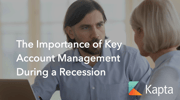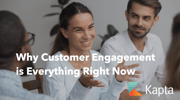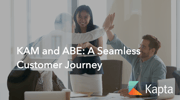How to Run A Great Client Workshop
in Customer Engagement /In a world with email and text and Slack and Zoom, it’s easier than ever to communicate with your clients remotely. And there are some real benefits to doing so—efficiency, flexibility, and consistency, to name a few. Telecommunication is an excellent resource for day-to-day deliverables.
But the more things change, the more they stay the same: Sometimes, you need a face-to-face meeting. As champions of client management, we like to pick those meetings apart, exploring what makes them work—or not.
We’ve posted before about how to run a great account review, and now we want to talk a little bit about how to run a great client workshop. So what makes something a workshop? Workshops are designed to do just that: Work. Through active discussion and participation, they generate ideas and insights while gaining alignment from key stakeholders. Examples include:
- Strategic workshops, such as a SWOT analysis, competitive war-gaming, audience mindset mapping, and more.
- Deliverables-based workshops, such as positioning and messaging workshops, designed to give your team the building blocks they need to deliver a first draft.
- Assessment and planning workshops, where you start to establish a baseline and create a path forward for change.
No matter what kind of workshop or meeting you’re running, there are always some ground rules. First and foremost, they’re about the client, not you. You can’t just talk at or lecture the room for an hour (or a day) and expect to be successful; you have to invite active participation, and listen carefully to what you hear. Second, the idea isn’t necessarily to solve everything in the room that day. Rather, it’s to gather insights and gain alignment so you can return to your office and put together a plan or deliverable you feel confident is going to exceed their expectations.
Now that we’ve established what we mean by workshop, let’s explore some pointers for running a great one.
Get the Right People in the Room
One of the key goals of any workshop is to gain alignment. Not only between you and your customer, but also among different groups within your client’s organization. A workshop skillfully facilitated by a trusted 3rd party (you) is an excellent opportunity to bring different points of view into the open, and hopefully even hash them out as a step towards resolution.
We’ll talk more about alignment later on, but we mention it here because the goal of alignment informs whom you invite to the workshop. Make sure you have relevant key stakeholders from different functions and levels within your client’s organization. If you’re running an assessment workshop to develop a rollout plan for new marketing technology, make sure you have more than marketing and leadership in the room. Invite someone from IT, as well as someone from training/HR and finance. Every department that eventually needs to be on board to make the initiative successful should be at the workshop you’re running.
Leadership should always be present, both from your organization and the client’s. From your side, it demonstrates commitment to the client and also gives managers a chance to understand the account dynamics. From the client side, leadership adds credibility to your meeting, and you’ll give decision-makers a chance to weigh in on the team’s thoughts and plans early on, so they are less likely to derail things down the road.
Finally, when considering whom to invite, try to create balance in the room. If there are too many of you, clients might feel outnumbered, and reticent to participate. If there are too many of them, you may not be able to track input and conversations well. If their senior leadership is present, make sure yours is, too. Nothing is a perfect, 1-for-1 situation, but a well-balanced room is more likely to be successful.
Prompt, then Listen
Remember, putting customers first means listening to customers. It’s tempting in a workshop situation to want to demonstrate your value and expertise—but this can turn into a lecture. The real goal is to unearth your client’s goals, expectations, insights, and concerns. Workshops are an invaluable opportunity to know your client better—but only if you listen.
Make sure when you’re planning your workshop (and putting the deck together) that you build in plenty of opportunities for active discussion and engagement. In fact, discussion and engagement are part of what makes it a workshop, rather than a presentation.
That said, don’t give your clients blank page syndrome. Nothing’s worse than posing an open-ended question to a room and getting…crickets. It’s always easier for people to react to something that already exists than to generate something from nothing, so do your homework and come prepared with things to react to. This could be well-informed ideas to get the conversation going, or templates for small group discussions, with examples of what you’re looking for so the client can wrap their heads around the exercise. You can even provide pre-reads or homework to get them in the right mindset, but be realistic about what people are willing to do.
An example of prompt, then listen could be a SWOT analysis. Spend time with your team prior to the workshop brainstorming 2-3 things you can add to each category (Strengths, Weaknesses, Opportunities, Threats.) That way, when you pull up the template in the workshop, you’ll have ideas ready to include, and they’ll have something to react to. The conversation will take off from there.
Use active listening skills, including repeating back what you’ve heard from the room. “Just to make sure I understand, you’re saying…” Use workshops to get absolute clarity from your customers.
Stand Up
It’s just a true thing about people: We need to move. The longer you sit in a room, the less engaged you’ll get. As a facilitator, you can invite active participation, and you can make sure it involves movement.
Here are a couple of examples:
- Break into small groups to work through exercises. Just getting up and moving to a new corner of the space can break a lull in energy. You can even send breakout groups to different rooms. Just make sure you send one representative from your organization with each group to facilitate the conversation, capture notes, and keep the group on task.
- Take notes on giant post-its on the wall, moving to different spaces for different exercises. If people need to vote on something, don’t ask for a show of hands. Instead, give them sticker dots and ask them to stand up and place their dots with their vote.
Look for minor ways to mix up the space and break up the day. You’ll get the blood flowing, and with it, the ideas.
Actively Seek Alignment
Gaining stakeholder alignment is one of the biggest benefits of a client workshop, so we’re going to return to it for a while here. In fact, if you sense competing factions within your customer’s organization, and you know that could be problematic for you down the line, it might be time to run a workshop, just to get everyone in a room to hash things out.
Let’s say you’re running a messaging workshop, and you’ve started with audience mindset mapping. Everyone has broken into small groups, and each group has taken on the role of a different audience type. They return to the main group to present their findings, and a rift emerges: Client leadership thinks their customer wants one thing. But the people who actually interact with customers know they want another.
For you as a facilitator, this moment presents tension, but also opportunity. Don’t whitewash over the disagreement; pause and explore. Remain neutral and observant, using active listening to repeat back what people have said. For example, “This is really interesting. I hear you saying X, and I hear you saying Y. I want to explore this a little bit more because it’s so important to understand your customers’ mindset.”
Remember, as a 3rd party facilitator, you can create a productive space for disagreements among your customers. By exploring those in a skillful way, you will (a) learn more about your customer, and (b) start to forge a path towards resolution.
Pay Attention to the Dynamics
Being in a room with your clients gives you a unique opportunity to read between the lines—but only if you’re paying attention. Who commands the room? Who influences the people around them? Where are there good relationships and connections you can leverage later on?
By observing your customers interact with each other, you can get a sense of the internal dynamics beyond what the org chart alone can tell you. But again, only if you’re paying attention—and that goes back to a main theme in running a great client workshop: Come prepared to listen.
Capture Great Notes
A great workshop is satisfying to everyone involved. Clients feel refreshed; they’re glad they came, even if it took time from their work week. Your team is refreshed; they have new ideas and insights to work with for the next deliverables. Everyone leaves on a high note.
But a lot of that work is wasted if you don’t capture great notes. The answer is pretty simple: You need at least one person in the room whose whole job is to capture notes. Whether it’s taking pictures with their phone of notes on a wall, or simply writing down what they hear in the room, they are fully dedicated to note-taking so that primary facilitators and participants can be fully dedicated to the people and the energy in the room.
Have A Plan for Follow Up
One of the most painful things that can happen in a workshop is going down a rabbit hole of detail when you don’t need to. The goal of a good client workshop is to generate ideas, gain alignment, and understand your clients better—not to wordsmith something to death.
You’ll find it’s easier to steer the conversation back to the task at hand if you have a clear plan for follow up. For example, “We’re going to take everything we’ve learned and discussed today and come back to you with 2-3 potential positioning statements. So don’t worry about exact wording right now.”
Once you have a plan for follow-up, make sure to follow through. Send notes and key takeaways sooner than later, to keep everyone’s memory fresh. Send applicable deliverables on a good timeline. The more you keep the momentum of the workshop going, the better.
Conclusion
Running a great client workshop is ultimately about making the most an in-person opportunity to engage clients, understanding them better so you can deliver even better work for them. Like anything, you can get better at running client workshops with practice, so if there’s someone at your organization who’s really good at it, make it your goal to attend workshops with them, and learn the fine art of facilitation.
At Kapta, client knowledge is the first pillar of Our KAM Process, and we provide tools—such as SWOT analysis planning—to help inform great workshops, and capture the results so the entire team can view what you learned. Because we’re champions of customer engagement, we’re also champions of great customer workshops.
To learn more about how we can support you in customer engagement, including designing and running engaging workshops, schedule your personal demo today.







